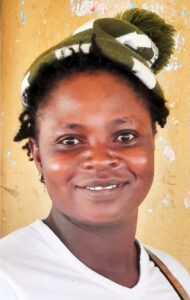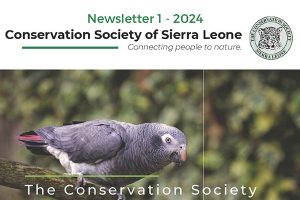 Hawa Puhunde, 29, is one of three women who are members of the Community Forest Management Committee (CFMC) in the town of Joru, headquarters of Gaura chiefdom, Kenema district in the Eastern Province of Sierra Leone. A mother of three, Hawa’s livelihood depended on the forest, like many others eking out a living in Sierra Leone’s lush forestland, through bush hunting, a practice that destroys the ecosystem by killing animals, including several endangered species on the International Union for Conservation of Nature (IUCN) Red List. Hawa was a thriving meat seller, netting daily sales of approximately 1 million Leones (US$100) with the income generated used to support her children.
Hawa Puhunde, 29, is one of three women who are members of the Community Forest Management Committee (CFMC) in the town of Joru, headquarters of Gaura chiefdom, Kenema district in the Eastern Province of Sierra Leone. A mother of three, Hawa’s livelihood depended on the forest, like many others eking out a living in Sierra Leone’s lush forestland, through bush hunting, a practice that destroys the ecosystem by killing animals, including several endangered species on the International Union for Conservation of Nature (IUCN) Red List. Hawa was a thriving meat seller, netting daily sales of approximately 1 million Leones (US$100) with the income generated used to support her children.
Demand for bush meat, a delicacy in Sierra Leone and Liberia, made the trade very profitable. But in 2021, Hawa was left with no alternative but to abandon the business after the people of Gaura signed a Memorandum of Understanding (MoU) with the Conservation Society of Sierra Leone (CSSL). The MoU essentially banned activities of deforestation, including hunting in Gayayeyei, the mountainous forest they relied on as source of livelihood. The chiefdom enacted laws that stipulate penalties, including a hefty fine of 500,000 Leones (US$25) on anyone engaging in activities that violate the ecosystem.
The Support Program for the Preservation of Forest Ecosystem in West Africa (PAPFor) in the Gola Rainforest, implemented by the Conservation Society for Sierra Leone (CSSL), has been working with the people of Gaura to conserve the ecosystem. With support from CSSL, Hawa and other community leaders have drawn up their own plan to save the forest, preserve their natural resources and livelihoods, and hence be a model for sustainable forest management.
“Before CSSL brought the PAPFor project to Joru, my livelihood depended on buying bush meat from hunters. I bought dead meat and dried them before selling in the market. I traded meat to communities as far as across the border in Liberia. The bush meat market was very profitable, and I used the profit to support my three children,” Hawa explained.
Since December 2021, Hawa and other women engaged in the trade, abandoned the booming business.
“Everyone in our chiefdom has committed to protecting our forest for our future generation,” Hawa said.
Community Forest Management Committee (CFMC)
 As a member of the 10-man Community Forest Management Committee (CFMC), Hawa works to promote conservation and diversify from traditional forest-based incomes, such as poaching, logging, pit-sawing, and hunting. The CFMC is a mechanism through which the local community plays a significant role in the management of the forest and land-use decisions making as changed agents. It involves the participation and collaboration of various stakeholders including community, government and non-governmental organisations. The level of involvement of each of the groups is dependent on the specific community forestry project and the management system in use.
As a member of the 10-man Community Forest Management Committee (CFMC), Hawa works to promote conservation and diversify from traditional forest-based incomes, such as poaching, logging, pit-sawing, and hunting. The CFMC is a mechanism through which the local community plays a significant role in the management of the forest and land-use decisions making as changed agents. It involves the participation and collaboration of various stakeholders including community, government and non-governmental organisations. The level of involvement of each of the groups is dependent on the specific community forestry project and the management system in use.
“Our aim is to ensure that deforestation is curtailed in the Gola and divert the inhabitants relying on the forest as source of livelihood to agribusiness and harvesting of non-timber forest products (NTFPs), such as rattan, honey, bush pepper, bitter-kola, etc.”, said Patrick Dauda, CSSL’s Land Use Planning, Community Forestry and Co-Management Coordinator.
Before PAPFor, the adjoining towns to Gayayeyei had struggled with the effects of deforestation and migration of distinct species due to widespread hunting, fuelled by the insatiable appetite for bush meat in Sierra Leone.
The Gaura case is not unique. In many other chiefdoms across the country, people are dealing with a mix of climatic and environmental changes that threaten their traditional way of life.
“Kenema district is one of those places that supplied other regions of the country and the markets in neighbouring Liberia and Guinea with bush meat. As a result, at one point in time, there was massive migration of some of the animal species distinct to our area. Moreover, logging and mining in the forest caused climatic changes, thereby drying out our only source of clean water from the hills,” said Silvanus Bockarie Foday, Town Chief of Joro, the chiefdom headquarters of Gaura.
Sierra Leone was losing vast hectares of forest, threatening the livelihoods of forest communities and endangered species such as the Red, White and Black Columbus, the Diana Monkey and Chimpanzees.
The PAPFor project aims to tackle these problems by working with rural communities to create awareness on the importance of protecting the forest while at the same time promoting alternative livelihood activities.
The establishment of CFMCs is a brilliant model of how working through community structures can change entrenched behaviour. The committees are indeed succeeding in tackling the destruction of the ecosystem in the forest communities previously experiencing deforestation.
“CSSL considers preserving the forest as a strategic way to curb climate change and help Sierra Leone adapt to and mitigate the impacts of climate change,” says Emurana Sowa, National Project Coordinator of PAPFor at CSSL.
To combat the upsurge of deforestation, CSSL has trained community and traditional leaders who have rallied local people around the idea that they can preserve the future of their unborn generations by conserving the forest.
“Our forest is our treasure. Destroying the forest means destroying ourselves. Before PAPFor, we were experiencing shortage of clean water and changes in the weather, which affected the farming season. Since we stopped cutting down the trees, things have improved. We will keep our forest for our children and children’s children,” remarked Bockarie Momo Konneh, member of the CFMC.
The Gola Rainforest Conservation Limited (GRC-LG) is also supporting the initiative. GRC-LG has supported over 100 farmers who have benefited from habitat restoration through agroforestry and sustainable conservation-friendly farming. Recently, GRC-LG distributed rice and cocoa seedlings to farmers.
Hawa is one of the beneficiaries of the GRC support. She is engaged in swampland farming and cultivation of other cash crops, such as eddoes, potatoes, peanuts and cassava. She now sells her yields in the weekly market and has diverted her livelihood away from the previous activities that were destroying Gayayeyei.
“Although I do not make the profit I made from selling meat, I will still sacrifice to keep our bush. I will manage the money I am making from my new business to support my children. Preserving our forest is a good idea”, concluded Hawa.
CSSL PAPFor has established 31 Community Forest Management Committees or Governance Structures across 6 chiefdoms in Gola Rainforest National Park Landscape and 1 chiefdom in the Kambui Hills Forest Reserve Landscape.
Story by: Mambu James Kpargoi
Photos: Abdul Kaprr Dumbuya



